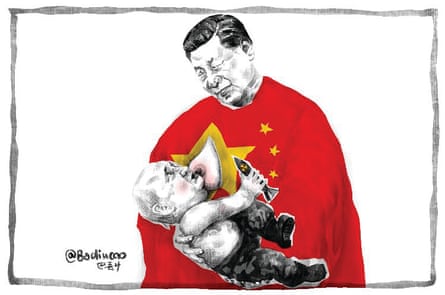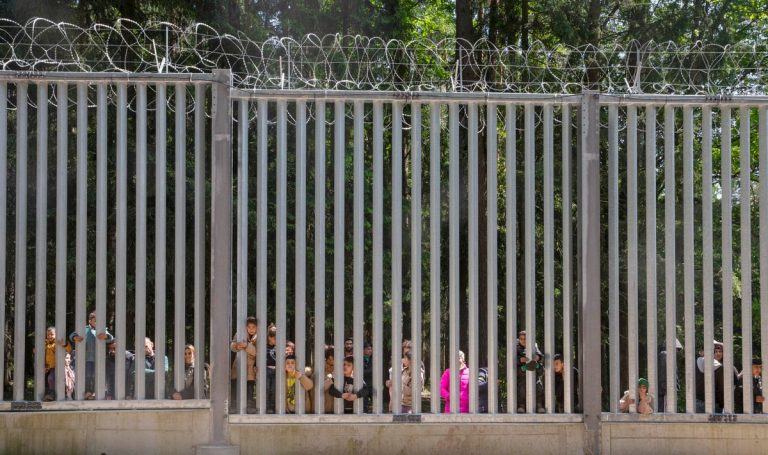‘People didn’t realise a funeral could be so beautiful’: Poland finds a new way to celebrate life – and death | Death and dying
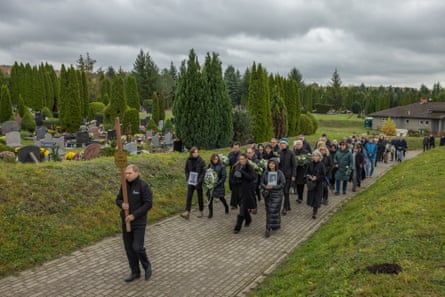
“Then, feeling really sorry for himself, he exclaimed: ‘There is fucking nobody to help me,’” reads Emilia Mandes, and the crowd bursts into laughter. They look at each other, nodding – this story has already become a family legend. But this is not an anecdote about a drunk uncle at a wedding. I am at a funeral: a special ceremony to say goodbye to Jan Ledwoń, who died in October at the age of 74.
Despite taking place in Elbląg, a medium-sized city in the north of Poland, it doesn’t feel like a typical Polish funeral. Instead of wreaths, people have made donations to a local animal shelter; instead of dirges, Leonard Cohen’s Tonight Will Be Fine is playing; and instead of a formally robed and solemn priest, there is Mandes, a professional celebrant, dressed modestly in black, and hugging the family and friends.
We are in a humble chapel next to the cemetery, with about 30 mourners. The chapel has allowed only half an hour for this farewell, but it is enough time for Mandes to deliver an emotional and moving speech about Ledwoń. As well as honouring his coarse language and crisp sense of humour, it reveals things that his friends weren’t aware of – that his parents wanted him to become a priest, for instance. Or that, when his father died, he promised his mother that he would replace him.
Such a ceremony is still a rarity in Poland, a predominantly Catholic country, in which the church has monopolised the celebration of most rites of passage. Although fewer and fewer Poles participate in religious rituals, they are still reluctant to give up traditional church ceremonies such as funerals or children’s baptisms. But recent years have brought changes: the Catholic church is in crisis and many Poles are turning to non-religious forms of spirituality, and as in other countries, there is now a growing “death positive” movement.
“The first ceremony I officiated at was the funeral of my husband. He died by suicide,” says Mandes, 47. “I wanted to respect his wish, in his final letter to me, to disappear unnoticed and avoid the ‘church circus’. Moreover, both of us left the institution a long time ago and our children are not connected with the church either.”
Mourners escort Jan Ledwoń’s ashes to the grave in Elbląg, northern Poland. Photograph: Anna Liminowicz/The Guardian
Mandes explains that her husband had depression, which he refused to acknowledge. It eroded their marriage and she decided to move on. “And then he decided to move on, as well,” she says. Two weeks spent with her husband in hospital in a coma gave Mandes time to think about how to organise his funeral. It was winter 2021, in the middle of the Covid lockdowns, so she had to negotiate limitations. But the main question was, if not a priest, then who would officiate at the ceremony? “I Googled Polish secular celebrants and knew my husband would haunt me if I hired one of them. They were more like celebrities than celebrants,” she says. “So, I decided to do it myself.”
A former actor and audiobook reader, she harnessed her writing skills to concoct a unique speech for her husband, and her acting skills to deliver it. She even used the occasion to raise awareness about depression. “Afterwards, people commented that they hadn’t realised a funeral could be so beautiful, so personal. Some time later, a friend told me that being a celebrant could be a profession and this is how I got to know the Institute of the Good Death,” she recalls.
Anja Franczak, 39, founded the Institute of the Good Death in 2020, after losing a child in 2015 and realising that society offered few tools to cope with the grief. She then discovered the roles of grief doula, end-of-life doula and celebrant, and trained in all three in Germany. “Doula” comes from the Greek word for “a woman who serves”, and is popularly associated with birth doulas, who help mothers navigate the beginnings of life. But the need for assistance with end-of-life matters has become more and more salient.
A grief doula is a non-medical professional who supports individuals or families experiencing loss. They help them to come to terms with death, navigate emotions arising from grief, and deal with practical issues, such as fulfilling the deceased person’s will. An end-of-life doula, in turn, guides a dying person through the process of passing and supports those important to them. Like a grief doula, they also help people come to terms with death, and deal with administrative issues such as planning a funeral. They also help communities recognise death as a natural and important part of life. A celebrant complements the doulas, supporting mourners and organising a farewell ceremony that honours the departed person.
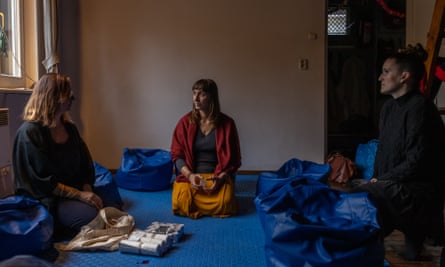 End-of-life doulas Katarzyna Boni, Anja Franczak and Magdalena Siwecka (left to right), about to start a workshop on the circle of grief. Photograph: Anna Liminowicz/The Guardian
End-of-life doulas Katarzyna Boni, Anja Franczak and Magdalena Siwecka (left to right), about to start a workshop on the circle of grief. Photograph: Anna Liminowicz/The Guardian
While training, Franczak started sharing the experience on her blog and received a lot of reactions from people who were fascinated by this new, fear-free approach to dying. Death is a taboo subject in Poland, as it is in many countries. According to research, 33% of Poles don’t think about it at all, and 27% very rarely.
“I don’t avoid death: on the contrary, I seek contact with it. My perspective on life has changed,” Franczak wrote on her blog. “I want to talk about life with the knowledge that we’re all going to die. I believe that this awareness offers us a chance to live an intense life in line with our values, to open up to a deep experience of being human and to have relationships full of respect, acceptance and love.”
Together with like-minded people she met along the way, Franczak created a grassroots collective that morphed into the Institute of the Good Death. Today, it has more than 100 members, including professionals from the funeral industry, experts in medicine and palliative care, psychologists, journalists, scientists and artists. They organise courses, lectures, meetings and events such as “death cafes”, informal open meetings during which people can talk about loss and grief.
Their aim is to foster conversation and education about end of life, death and grief in a sensitive and supportive way. The institute also aspires to transform the culture from one in which death is absent or censored into one that draws from transience for our benefit, to enrich and enliven us. “We want to empower people to keep each other company in life and in death,” says Franzcak. “To raise awareness that we do not necessarily have to outsource all things concerning dying to institutions. We can deal with many things ourselves.”
It’s incredible how we are able to bond when we stand together in the face of death
The institute does not oppose the church or tradition, she stresses: “Many Poles value these religious, Catholic rites. We are open to collaboration with priests.”
One notable aspect of the institute is that it attracts mainly women; few men have participated in courses or events. “Maybe it’s because, for some reason, topics of life and death, childbirth and dying are closer to women,” says Franczak. Mandes suggests it might also be down to a difference in socialisation between men and women, “and the fact that what we do at the institute is perceived as care work, historically associated with women”.
 Emilia Mandes conducts the humanist funeral ceremony of Jan Ledwoń. Photograph: Anna Liminowicz/The Guardian
Emilia Mandes conducts the humanist funeral ceremony of Jan Ledwoń. Photograph: Anna Liminowicz/The Guardian
Back in Elbląg, after the ceremony, Mandes invites mourners to the cemetery, where Ledwoń’s ashes will be returned to the soil. “He chose the forest as a place to say goodbye to this world. It leaves us in pain. If you feel that you want to tell him something, recall some memory, thank him for something, get angry about something, forgive him for something, you may express it with a metaphorical letter in the form of an autumn leaf,” she says.
As orange and red leaves fall on to Ledwoń’s grave, Mandes plays one of his favourite songs, Whitney Houston’s I Will Always Love You. This is the saddest moment of the funeral and Ledwoń’s widow, Magda, bursts into tears, hugging her husband’s photo in her arms. “You may now get closer to the family and hug them,” encourages Mandes, and the crowd clings together, forming a swinging mass.
“It is one of these rare experiences that really unite people,” Mandes says later. “It’s incredible how we are able to bond when we stand together in the face of death. It is above all divisions, all polarisation.”
A few days earlier, on 1 November, it was All Souls’ Day, a day when Poles do commune with the dead. On this day, Polish cities are typically deserted, but the cemeteries are bursting with life. Trains and motorways all over the country fill up with those travelling to visit the graves of the departed, and necropolises are covered in flowers and flickering candles. It is a time reserved for family and friends, and for remembering those who have died.
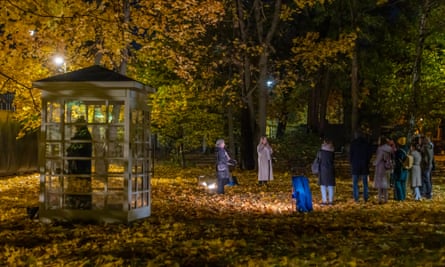 The Wind Phone Booth, where mourners can ‘communicate’ with those who have died. Photograph: Anna Liminowicz/The Guardian
The Wind Phone Booth, where mourners can ‘communicate’ with those who have died. Photograph: Anna Liminowicz/The Guardian
As dusk falls, Warsaw’s historic Powązki cemetery becomes as busy as an airport. People who have come to visit graves mingle with those collecting money for charity, and vendors of candles and chrysanthemums. The place is dotted with booths housing priests selling commemorative masses.
But Mandes is not there. “I’m not going to the cemetery today,” she told me. “I don’t like crowds and I want to show my children that a connection with the dead is not limited to one day in the year.” Instead, across the city from Powązki cemetery, in the Osiedle Jazdów – a cultural commune housed in tiny houses in the centre of Warsaw – she is preparing an “open grief ritual” organised by the institute. This small ceremony is aimed at helping people honour and remember the deceased and engage in the process of letting go. Wading through autumn leaves in a small public square, Mandes and two other celebrants place lit candles in various corners and set up a microphone. A dozen participants observe them curiously. Some of them use the Wind Phone Booth, an imitation phone box installed by the institute in May 2022, where mourners can “communicate” with those who have died (the line is not connected to anything).
“I will give each of you a ribbon. It will be your bridge to your departed person and will let you connect with them,” says one of the celebrants, and divides the group into small circles. After a moment of awkward silence, each of the circles starts resounding with words, and soon with sobbing. “I wanted to thank you for being such a great auntie …”, “I wanted to say sorry that you couldn’t die in your beloved flat …” As the stream of words intensifies, I cannot believe that these people are able to show such vulnerability despite being complete strangers.
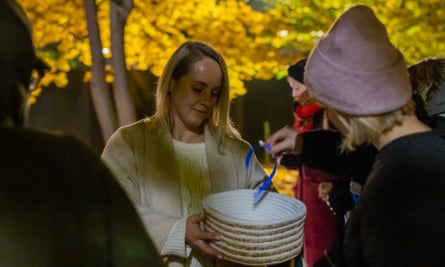 Mistress of ceremony Dominika Galza offers blue ribbons as a symbol of connecting with a loved one who has passed away. Photograph: Anna Liminowicz/The Guardian
Mistress of ceremony Dominika Galza offers blue ribbons as a symbol of connecting with a loved one who has passed away. Photograph: Anna Liminowicz/The Guardian
“I came here exactly for that,” says Monika, 44. “I am not ashamed – I want to cry among strangers.” She explains that she knew about the ritual from social media. “It is a relief to discuss emotions concerning death and grief that in Poland have been suppressed for years,” she adds.
The ritual led by Mandes and her fellow celebrants is vaguely reminiscent of the pre-Christian Slavic rite of Dziady (Forefathers’ Eve). This “communion of the living with the dead” involved gathering in houses to feed wandering souls with honey, barley, eggs and vodka. It was an occasion to share grief with the living and talk to the dead.
At the end of Ledwoń’s funeral, as his brother and sister-in-law, Jerzy and Marzena, say their goodbyes, I ask them what they thought of the ceremony. “I loved it,” says Jerzy. “I’m enrolling my name in Emilia’s agenda.”
“Not so fast,” says Marzena. “You still have a couple of dozen years to live.”

